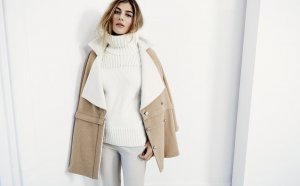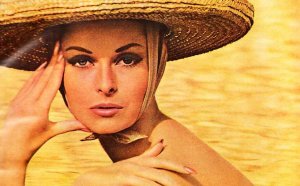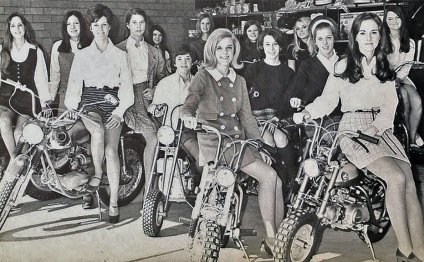
1965 Fashion trends
The fashion 12 months ended up being a varied one, with enough trends to deliver options for even many individualistic girl. The Italians feuded about whether Florence or Rome should be their style center; the French had been the French—minus the famous Andre Courreges, just who forsook haute couture for ready-to-wear; the English remained due to their Mod appearance; the People in america, as always, combined creativity and mimicry.
Mondrian into the Limelight. The couture sweepstakes had been obtained by Yves Saint-Laurent ( with the help of Piet Mondrian). Saint Laurent's playful shift outfits of Mondrian-inspired color blocks swept through intercontinental fashion world with just as much strength as performed the Courreges look. And, like Courreges appearance, the Mondrian look starred in all selling prices and all sorts of forms of garments, from changes to hats—and sweaters, jeans, and kerchiefs.
Fall Couture. On American region of the Atlantic, haute couture ended up being creating a unique type of the no-waist dress—a much older one. Norman Norell, harking to the Roaring Twenties, produced period outfits complete with bugle beads, fringes, spaghetti straps, flat bosoms, and waistlines that sat round the hipline.
Various other American developers opted for a more intimate try to find fall. Evening dresses glittered with jewel beads, jet, sequins, and rhinestones, or swayed with the undulation of feathers. Materials ranged from lush velvets and satins and cire brocades to understated wool flannel. Ensembles—dresses with matching coats—were preferred for almost all the time. Additionally the long gown once more dominated the night.
The most used designs for evening were a Western type of the sari, the one-shouldered long gown that every-one liked, originated by Oleg Cassini for Mrs. Jacqueline Kennedy, and straight-across strapless neckline on a floor-length gown. Discotheque dresses got steadily lowering interest while the discotheque trend went into its, final phases.
As the year wore on, fascination with the ultra adorable little-girl clothes waned. In its stead, the big news had been a dress which had no title. It was instead free, well-cut, and skinny, occasionally with smocking at the top, typically with long, fluid sleeves and contrasting rings of jewel beads during the wrist and neck.
Spring. The springtime look in sportswear was mostly variations on a style by Courreges, as United states manufacturers ground away look-alikes in all prices.
Sharing the springtime spotlight had been that English import, the Mod dress—high-waisted and loose of top, with contrasting patterns eg dots and stripes. The poor-boy sweater, a skimpy, clinging, ribbed knit, was also well-liked by younger ladies.
Summertime. With summer emerged the very first genuine breathing of fresh air, as fishnet instantly showed up and caught the popular fancy. Swimwear, beach jackets, and jumpsuits all used the meshlike fabric, towards the evident delight of hundreds of thousands.
The coastline ensemble was another frequent sight regarding the beach. It consisted of a swimsuit and a matching jacket or quick change for cover-up security and a coordinated appearance.
Off the coastline, brilliant prints—Tahitian florals, but the majority especially vivid paisleys—were used in everything from streetwear to evenings at home. And once the sun's rays sank, so did the hemlines; lengthy clothes became de rigeur in some sectors for at-home and patio enjoyable as well as for the greater amount of formal tasks of evening.
The packable, crushable, washable move who has for ages been a summer specialty longer its reign. This design, made popular by Emilio Pucci, normally made well by numerous United states clothing houses, one of these Wilroy. Often in vivid patterns on silk or a light synthetic, these dresses would be the response to a traveler's fantasy, and serve similarly well for workplace or road wear.
Fall. Since the Christmas vacations approached, the world of sportswear switched silver. Gold jumpsuits, metallic mesh skirts and blouses, aluminum-like dresses and slacks, all brightened up the appearance of winter months.
Pants were because common as previously, but this current year bell-bottomed trousers were the vogue in anything from denim to crepe.
Two of the diets that relocated the younger ready had been a continued rage for pierced ears in addition to "granny" gown, a fresh development, which will be what its title implies—a loose, ankle-length cotton dress with puffed sleeves and a plain neck. Its use had been rather limited to really young people at beaches and hotels. Their particular elders, meanwhile, moved in droves to where in actuality the men were—to Army-Navy stores—where they depleted materials of hell-bottoms, Navy pea jackets, and chief petty officials' t-shirts as fast as they could.
Accessories. Patterned stockings were in favor over summer and winter. Sheer designs and large wool cable knits lured ladies; wildly patterned stockings or high sox fascinated the younger ladies, particularly when the hosiery matched the blouse in what had been known as the "total appearance."
Furs looked different, too. They shed their seriousness and only frivolity, whimsy, and a decidedly sporty look. Some had holes like Swiss cheese, some had been polka-dotted or designed in stripes or paisley. Ermine had been abnormally preferred, even for daytime, and such less products as monkey, rabbit, and many different cats became posh.
Hats changed little. Fur, particularly mink, ended up being since desirable as ever. Kerchiefs had been the rage, in brilliant patterns inside warmer months as well as in fur when it comes to autumn. As for cloth caps, various helmet kinds had been seen, some despite chin straps—but mostly it absolutely was per year of kerchiefs and fur.
In this way, tresses had been much more essential than caps. Vidal Sassoon, the trend of London, exposed a hair salon in New York, and countless females had their particular hair slashed into a short, sharp, angular cap that showcased irregular bangs and points within the back. In addition seen, throughout the warm months, was the Tom Jones—a everyday coiffure with hair negligently pulled straight back, much like the period look from motion picture of the same name. Wigs and tresses pieces were in regular use, along side detachable individual curls.
The total blossoming of at-home use ended up being an undeniable fact of 1965. Ladies had been faced with a huge, bountiful variety where formerly there have been bit. Floor-length skirts, robes, and culottes were highly popular, alongside monks' robes, in materials which range from quilted velvets and velours to crepe and dotted swiss. Feathered plus furred peignoirs, robes, and sleep coats had been luxuries set aside for a moneyed couple of.
Hairstyles
The season had been among great womanliness in hairstyles. Very pretty, soft, however very organized types prevailed. Minds were little. There is little if any backcombing of this tresses, which was sculptured to follow along with the form for the head although not to cling. Formed to give controlled bounce and freedom of motion, it moved in liquid lines without model ringlets or free traveling finishes. Hair size had been either very long or very quick.
RELATED VIDEO
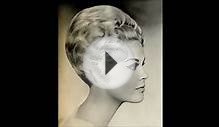
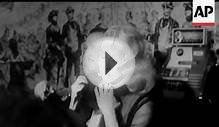
Share this Post
Related posts
Winter Style
WinterStyle.com specializes in premium quality winter months outerwear accessories. Discover the seasons hottest winter months…
Read More1964 Fashion trends
Continuing the trend begun in the latter element of 1963, ladies fashions in 1964 moved still further from the right lines…
Read More
